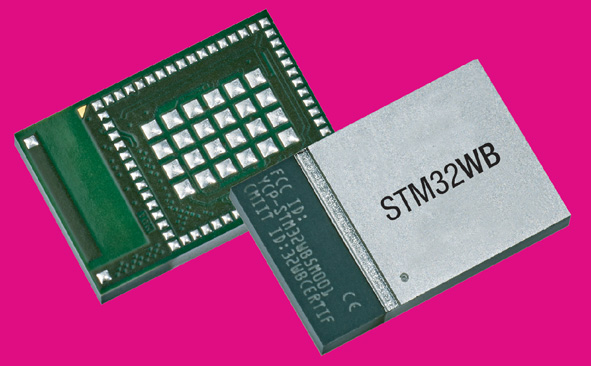STM module accelerates IoT device development
- January 6, 2021
- Steve Rogerson

Swiss semiconductor company ST Microelectronics hopes its latest module can accelerate the market introduction of Bluetooth LE and 802.15.4 based IoT devices.
The STM32 WB5MMG wireless microcontroller (MCU) module measures 7 by 11.3mm and lets product teams build connected devices without needing wireless-design skills.
Made to enable low-cost PCB technology requiring few layers, it integrates everything up to the antenna. Users can also leverage the tools, design wizards, radio stacks and turnkey software libraries of the firm’s STM32 Cube MCU development ecosystem, available for free, to complete the project.
“Our first STM32-based wireless module simplifies technical challenges and extends exciting opportunities for smart connected devices,” said Ricardo de Sa Earp, group vice president at ST Microelectronics. “A complete ready-to-use subsystem in a single package, the STM32 WB5MMG assures excellent radio performance out of the box and comes certified according to Bluetooth, Zigbee and OpenThread specifications.”
In addition, the module supports STM’s concurrent dual-protocol mode that lets any protocol based on IEEE 802.15.4 radio technology, including Zigbee 3.0 and OpenThread, connect the user directly to any Bluetooth Low Energy device.
Benefitting from the features of the STM32 WB55 low-power wireless microcontroller ICs, the module addresses applications for smart-home, smart-building and smart-factory equipment. Users can leverage the MCU’s dual-core architecture that separates radio and application-level processing for unimpeded performance, large memories for radio and application code and data storage, and cyber security.
Designers can create a simplified, low-cost PCB leveraging the module’s optimised pin-out and take advantage of existing STM32 WB55 MCU firmware libraries and toolchain. In addition, STM has created a dedicated application note as extra guidance for module users.
The module integrates a miniature antenna properly matched to the receiver circuitry, built-in switched-mode power supply circuitry, and frequency-control components. With support for crystal-less USB Full Speed connectivity, the module helps users reduce materials costs as well as simplifying the hardware design.
Cyber protection includes secured software updates such as over-the-air for brand protection and device integrity, user key storage and proprietary code readout protection to protect developers’ intellectual property, and PKA support for cryptographic protection of code and connections.




